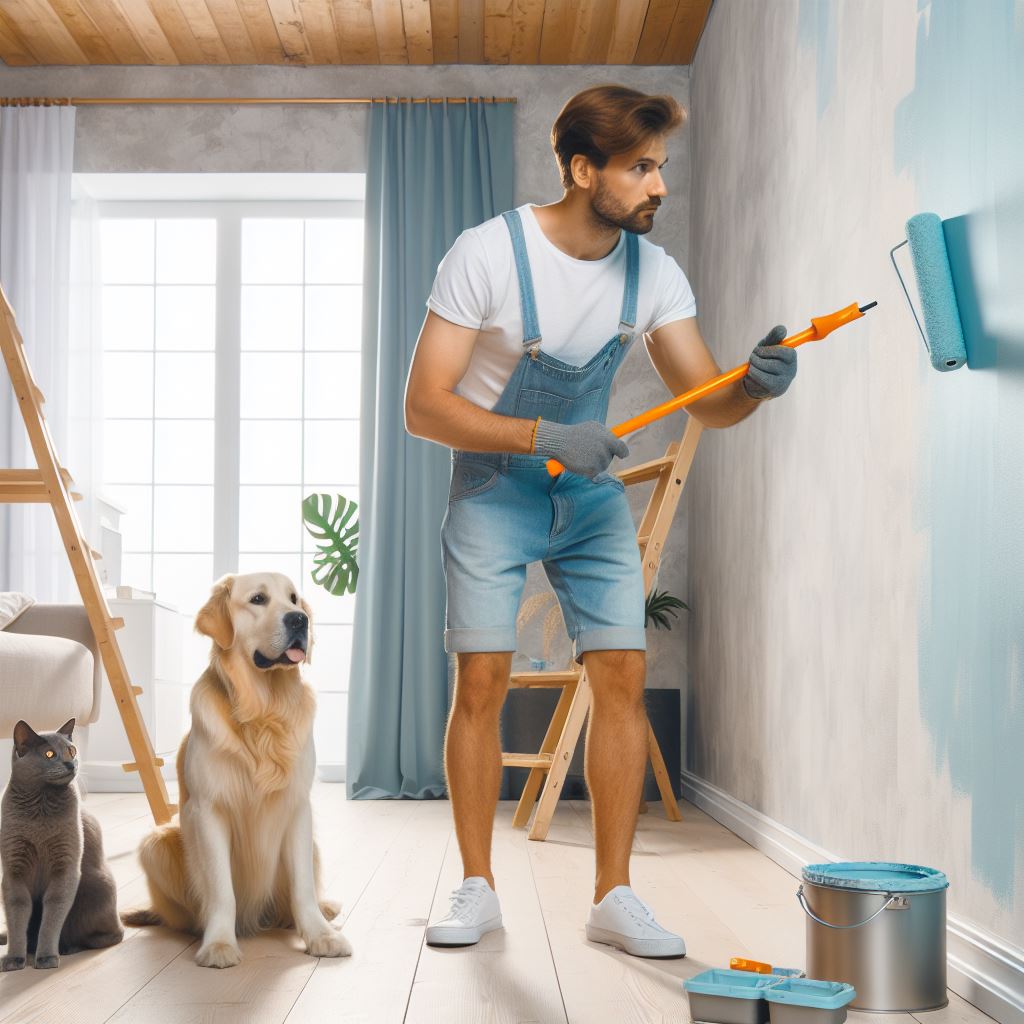If you’ve ever attempted to paint your home, you know it can be a daunting task. From selecting the right colors to achieving smooth, streak-free walls, there are several common mistakes that can hinder your painting project. But fear not, because in this article, we’ll guide you through the most common pitfalls to avoid when painting your home. Whether you’re a novice or a seasoned DIY enthusiast, by following these tips, you’ll be well-equipped to tackle any painting project with confidence and achieve professional-looking results. Get ready to transform your living space with a fresh coat of paint, and say goodbye to those pesky mistakes that can sabotage your efforts!
Choosing the Wrong Paint
When it comes to painting your home, one of the first mistakes you can make is choosing the wrong paint. Failing to consider the type of surface you’re working with can lead to a lackluster finish and paint that doesn’t adhere properly. Different surfaces require different types of paint, so it’s essential to do your research and choose a paint specifically designed for the material you’re painting.
Another critical factor to consider is the right finish. The finish you choose can drastically affect the overall look and durability of your paint job. Glossy finishes are excellent for high-traffic areas as they are more resistant to stains and easier to clean. On the other hand, matte or satin finishes are better suited for rooms where you want a subtle, soft appearance. Take the time to understand the finishes available and select one that complements the style and functionality of your space.
Lastly, neglecting to test the color before diving into the painting process is a common mistake. Colors can look drastically different when applied to a large surface, and what looked great on a tiny paint swatch may not look as appealing on your walls. To avoid disappointment, pick up a small sample of your chosen color and test it on a small area of your wall. This simple step will ensure you’re happy with the color before committing to the entire project.
Skipping Surface Preparation
Surface preparation is a crucial step that should never be skipped when painting your home. Not cleaning the surface before painting can lead to poor adhesion and a patchy finish. Dust, dirt, and grease hinder the paint’s ability to adhere to the surface, resulting in an uneven application. Take the time to thoroughly clean the surface with a mild detergent and water solution or a degreaser if necessary. This will ensure a clean canvas for your paint and promote better and longer-lasting results.
Additionally, forgetting to repair or patch any damaged areas on the surface can lead to a less-than-perfect finish. Cracks, holes, and other imperfections need to be filled and smoothed before painting to achieve a seamless and professional look. Use a suitable filler, allow it to dry, and then sand the repaired area to create a smooth surface for painting. This extra step will make a significant difference in the final appearance of your paint job.
Inadequate Protection
Protecting your furniture, flooring, fixtures, and hardware is another area where many people go wrong. Failing to adequately protect these items can result in accidental paint splatters and damage. Before you begin painting, remove as much furniture as possible from the room or cover it with drop cloths or plastic sheets. This will prevent any accidental paint splatters or spills from ruining your belongings.
Similarly, cover your flooring with drop cloths or plastic sheeting to protect it from paint spills, drips, or splatters. Paint can be challenging to remove from certain flooring materials, so taking this precautionary step will save you time, effort, and potentially costly repairs. Don’t forget to also cover fixtures, hardware, and anything else that you don’t want to get paint on. By taking the time to protect these items, you can focus on your painting without worrying about accidental damage.
Poor Planning
Before you start your painting project, it’s crucial to have proper planning in place. Lack of proper budgeting is a common mistake that can lead to unexpected expenses and frustration. Take the time to calculate how much paint you’ll need, including any additional supplies like brushes, tape, and drop cloths. Research the prices of these items and set aside a budget that suits your needs. By planning ahead, you can avoid overspending and ensure you have all the necessary materials on hand.
Another aspect of poor planning is insufficient time allocation. Painting is not a task that can be rushed, and underestimating the time required can lead to a haphazard finish. Consider the size of the area you’re painting and allocate enough time for each step of the process, including surface preparation, priming, painting, and drying. This will ensure that you can work at a leisurely pace, be thorough in your application, and avoid any unnecessary mistakes due to rushing. Proper planning will contribute to a smoother and more enjoyable painting experience overall.
Improper Use of Painting Tools
Using the right painting tools is essential for achieving a professional-looking finish. Not using high-quality brushes or rollers can result in visible brushstrokes or an inconsistent application of paint. Investing in high-quality brushes and rollers will make a noticeable difference in the final result. These tools will help you achieve smooth, even coverage and reduce the time and effort required for touch-ups or corrections.
Using the wrong type of brush or roller is another common mistake that can affect the outcome of your paint job. Different brushes and rollers are designed for specific paint types and surfaces. For example, using a foam roller on a textured wall can result in an uneven application and a less appealing finish. Take the time to understand which brushes and rollers are suitable for your specific project, and choose accordingly. The right tools will make your painting experience more enjoyable and the final result more professional.
Inconsistent or Incorrect Technique
Applying paint without proper technique can lead to a less-than-desirable result. Failure to prime the surface before painting is a common mistake that can result in uneven coverage and poor adhesion. Primer creates a smooth and uniform surface for the paint to adhere to, resulting in better color saturation and a longer-lasting finish. Don’t skip this important step, particularly when painting over bare or porous surfaces.
Applying too many or too few coats of paint is another pitfall to avoid. Too many coats can result in a thick, uneven finish, while too few may leave patches or streaks. Follow the instructions provided by the paint manufacturer regarding the recommended number of coats for your specific paint. This will help you achieve optimal coverage and ensure a consistent appearance across the entire surface.
Allowing adequate drying time between coats is equally important. Rushing the drying process can lead to smudging and an uneven final result. Follow the drying time guidelines provided by the paint manufacturer to ensure that each coat has fully dried before applying the next. This patience will result in a more professional-looking finish and a more satisfying painting experience overall.
Painting in Unsuitable Weather Conditions
Painting in unfavorable weather conditions can negatively impact the outcome of your project. Not checking the temperature and humidity levels before painting can result in paint that doesn’t dry properly or adheres poorly. Ensure that the temperature and humidity are within the recommended range specified by the paint manufacturer. Ideally, paint in moderate temperatures and when the humidity is relatively low to achieve optimal results.
Painting in direct sunlight can also pose challenges. The heat from the sun can cause the paint to dry too quickly and result in an uneven finish. Similarly, painting in extreme cold can affect the paint’s ability to adhere properly. Whenever possible, choose a time of day or year when the room or area you’re painting is shielded from direct sunlight and the temperature is within the recommended range. This will help you achieve the best possible results from your painting project.
Neglecting Safety Measures
When it comes to painting, safety should always be a priority. Not wearing protective gear can pose health risks, particularly when using paints that contain harmful chemicals. Before you start painting, make sure to wear protective clothing, gloves, goggles, and a mask to prevent exposure to paint fumes, dust, or other potentially harmful substances. Additionally, ensure that you’re working in a well-ventilated area to minimize the inhalation of paint fumes.
Using flammable materials near open flames is another safety hazard that should be avoided at all costs. Many paint thinners, solvents, and other painting materials are flammable and can catch fire if brought near an open flame. Always read and follow the instructions and warning labels on these products and handle them with care. Keep them away from open flames or any potential sources of ignition, ensuring the safety of yourself and your surroundings.
Incomplete Surface Coverage
Applying paint unevenly or missing areas can significantly impact the overall appearance of your paint job. Leaving gaps or visible lines can make the paint job look unprofessional and unfinished. Take your time when applying the paint and ensure that you cover the entire surface evenly. Pay close attention to corners and edges, as these areas are often overlooked but can be noticeable if left unpainted. By being thorough in your application, you’ll achieve a seamless and polished finished result.
Ignoring Maintenance and Touch-Ups
Once your painting project is complete, it’s important not to neglect the painted surface. Not maintaining the painted surface can lead to wear and tear, making the paint job look old and worn out quickly. Regularly clean the painted walls with a soft cloth or sponge to remove any dirt or grime that has accumulated. Additionally, touch-ups may be necessary over time to fix any chips, scratches, or dings that may occur. Keep a small amount of your chosen paint on hand for touch-ups and address any imperfections promptly. By properly maintaining and attending to your painted surfaces, you’ll keep them looking fresh and vibrant for years to come.
In conclusion, painting your home can be a rewarding and transformative project. By avoiding common mistakes such as choosing the wrong paint, skipping surface preparation, inadequate protection, poor planning, improper use of painting tools, inconsistent or incorrect technique, painting in unsuitable weather conditions, neglecting safety measures, incomplete surface coverage, and ignoring maintenance and touch-ups, you can ensure a successful and satisfying painting experience. Follow the tips and guidelines provided in this article to achieve a professional and beautiful paint job in your home. Happy painting!




